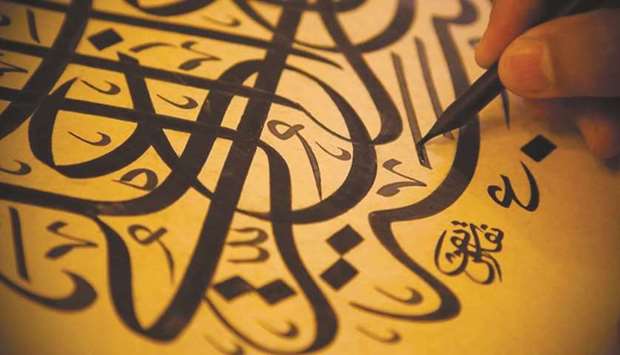For many centuries, the Middle east, has been and continues to be a place where both its populations and its cultures leave a living stamp on the rest of the world. In this case, we will discuss the significance of the Arabic language and its reflection on Western Europe.
According to many historians, the Arabic language took part of the European world during the middle Ages in the Balkans, in southern Italy, in Portugal and in Spain.
The Arab culture and the Muslim influence in the Iberian Peninsula had mainly a significant and prolonged permanence seen in the architecture of many historical monuments; enriched by the Arabic language, leaving thousands of words easily traced.
Arabic was a major vehicle of culture in Europe, especially in science, mathematics and philosophy. As a result, many European languages have also borrowed many words from it. Arabic influence, mainly in vocabulary, is seen in European languages—mainly Spanish and to a lesser extent Portuguese, Catalan, and Sicilian—owing to both the proximity of Christian European and Muslim Arab civilizations and the long-lasting Arabic culture and language presence, mainly in Southern Iberia, during the Al-Andalus era.
Since 1973, Arabic has officially become an official language of the United Nations joining the Spanish, English, Chinese, Russian and the French language. Arabic is a Semitic language that first emerged in the 1st to the 4th centuries CE. It is a language that has more than 30 dialects flowing from the different Arabic-speaking countries.
The Arabic language is estimated to be made up of 12mn words, with outstanding language academies such as in Cairo, Egypt established in 1934; in Damascus, Syria since 1919; and in Khartoum, Sudan and Mogadishu as well as in Fes, Morocco. There are 280mn Arabic speakers in 33 countries and in a large majority (20) as an official language.
Due to the aforementioned Muslim presence in the Iberian Peninsula in the 7th century, the Al-Andalus province and then the Caliphate of Córdova were created. The presence was very important in cities such as Malaga, Granada, Córdova, Alicante and the islands of Menorca and Mallorca. They had a library in Córdova which was the source of inspiration to translate the work of Aristotle and Plato. In addition to the library, one of the most famous examples of Arab-Muslim influence is the Great Mosque at Cordoba, which is now a Catholic cathedral.
Due to the large influence of Arabic on Spanish vocabulary, many Spanish words derived from other Arabic words; some words hold the same meaning but consist of a different accent or way of pronunciation. The letters “AL” for example, is used in most of the Arabic words to definite article meaning “The”. Found till today within several Spanish last names such as Alcalá, Alfaro, Almodóvar, Almaraz, Alcantara, Alcaraz, Alerce, Almagro, Almeida, Alfares, and Almirante, etc.
On the other hand, Arabic words have also a significant influence in agricultural vocabulary. Per example: azafrán (saffron), azahar (orange blossom), azucenas (lilies), algodón (cotton), alerce (larch), ajorca (anklet), aljibe (cistern), alberca (water tank), albaricoque (apricot), limón (lemon), acelga (chard) and alcachofas (artichokes). Additionally, the classic Arabic word sukkar and the Hispanic-Arabic assúkkar gave birth to azúcar (sugar).
Due to the history of the occupation, several other contexts also possess Arabisms — words relating to the military: aljaba (quiver), aceifas (harvests), atalaya (watchtower), zaga (rear) and alcazabas (citadels); and scientific terminology: algoritmo (algorithm), álcali (alkali), álgebra (algebra), cifra (cipher) and alquimia (alchemy).
Thus, the relationship of Arabic with the Spanish language is a situation of two languages that coexist and are delimited in certain fields.
On the other hand, it is worth mentioning that since the middle of the last century, the Arabic language begins a process of expansion at a global level, and in many countries. Communication is expanded with this ancient language; not to mention other languages, such as English, Mandarin Chinese, Hindi, and French, which historically have been present for many centuries in the world.
The importance of the Arabic language lies in its strong and fundamental relationship with a planetary religion, Islam.
The Arab presence that we have in our country, Peru, which is represented in our capital, Lima, with the “Club Unión Árabe Palestino”, whose objective is to keep latent the culture of their ancestors, as well as of numerous diplomatic missions, in the one that stands out the embassy of Qatar goes back to the numerous Arab migration to America by the end of the 19th century, mainly from Palestine, Syria and Lebanon.
It is also worth highlighting that the Arab world took its parts in spreading its culture and artistic talents through its music, arts and literature in which some Arabic words were adapted within several fields.
According to professor in General Linguistics of the University of Jordan, Ziyad Mohamed Gogazeh, Arabic and Spanish might have their differences but they also hold many similarities.
There is no question that the Arab impact on Spain made it the leading country in Europe for many centuries. Arabic was not only spread due to the arrival of Arabs around the globe but the introduction of Arabic goes also back to the introduction of Islam and its presence in the Iberian Peninsula bearing a superior.
The tongue of the desert men has conquered the world and established its footprints among many nations. This advanced culture of the Arab people that I have personally witnessed and still witnessing in Qatar manifest the development and the importance of such a powerful medium of communication: the Arabic language.

Arabic script Arabic Calligraphy


